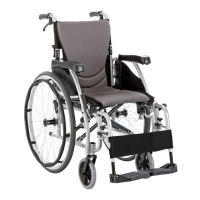
Do you have a question about the Karma S-Ergo 100 Series and is the answer not in the manual?
| Legrest Type | Swing-away |
|---|---|
| Frame Type | Folding |
| Frame Material | Aluminum |
| Wheel Size | 24 inches |
| Armrest Type | Fixed or adjustable height |
| Rear Wheel Size | 24" |
Wheelchair assembly and repairs must be done by authorized KARMA dealers. Order parts through them.
Unauthorized repairs, upgrades, and parts void warranty. Always use authorized service providers.
Consult therapist for amputees; use anti-tippers for stability.
Follow Highway Code and manual guidelines when using outdoors.
Manual covers operation, safety, symbols, repair, and warranty for S-Ergo 100 series.
Explanation of WARNING, CAUTION, and SUGGESTION symbols for safe operation.
Operate on level surfaces, use ramps, maintain balance, avoid leaning, and use brakes properly.
Instructions for inclines, kerbs, stairs, streets, potholes, and rough terrain.
Use caution crossing streets. Avoid potholes and rough terrain that can get casters stuck.
Ensure brakes are applied. Keep feet on footrests, clothing away from wheels.
Push gently on pushrims. Clean upholstery with mild soap and water, avoid solvents.
Consider anti-tippers. Adhere to maximum user weight limit for safety.
Use responsibly; careless use endangers self and others. Do not let children play on wheelchair.
Read and protect all wheelchair labels for future reference.
Step-by-step instructions on how to unfold the wheelchair correctly and safely.
Step-by-step guide on how to fold the wheelchair, including armrest flip for S-Ergo 125.
How to install swing-away footrests and adjust footplate height.
Instructions on adjusting the backrest angle for the S-106 model.
How to adjust armrests and safely transfer into the wheelchair.
Procedure for safely exiting the wheelchair, including engaging brakes.
Tips for general use, attendant pushing, and self-propulsion.
How an attendant can tilt the wheelchair for obstacles or positioning.
User's method for tilting the wheelchair to overcome obstacles.
Instructions for going down kerbs forwards and backwards with an attendant.
Method for going up kerbs forwards and backwards with an attendant.
Guidelines for going up or down steps/stairs with attendants.
Proper procedures for folding, storing, and transporting the wheelchair in vehicles.
How to properly secure the wheelchair in a vehicle using tie-down systems.
Detailed steps for fitting front, rear, and seat restraints for transport.
Instructions for attaching, detaching, adjusting, and using the pelvic belt.
Daily inspection points for brakes, handgrips, anti-tippers, and structural integrity.
Schedule and checklist for regular maintenance of wheelchair components.
Checks for armrests, footrests, tyres, and general wear.
Magnesium Alloy Rear Wheel, I.V. Pole Holder, Oxygen Tank Holder, Backrest Bag.
Anti-Tippers and Multi-Purpose Safety Belt for enhanced user safety.
Diagnosing and correcting veering, sluggish turns, and performance issues.
Troubleshooting caster flutter/wobble and general looseness in the wheelchair.
Addressing squeaks, rattles, and general looseness in the wheelchair.
Details on model variants, frame color, seat dimensions, and brakes.
Overall length, width, height, collapsed dimensions, and weight.
Specifications for seat width, depth, height, and backrest height.
Weight capacity, total weights, and shipping dimensions.
Comparative specifications for S-Ergo 105II, S-Ergo 106, and S-Ergo 125 models.
Instructions for cleaning the wheelchair frame and upholstery.
Guidelines for recycling wheelchair materials like aluminum, plastic, and paper.
Details on what is covered by warranty and items not covered.
Responsibilities of the user and the dealer for warranty and maintenance.
Consumables not covered, warranty duration, and transfer of rights.
Forms for recording user, purchase, and dealer information for warranty.